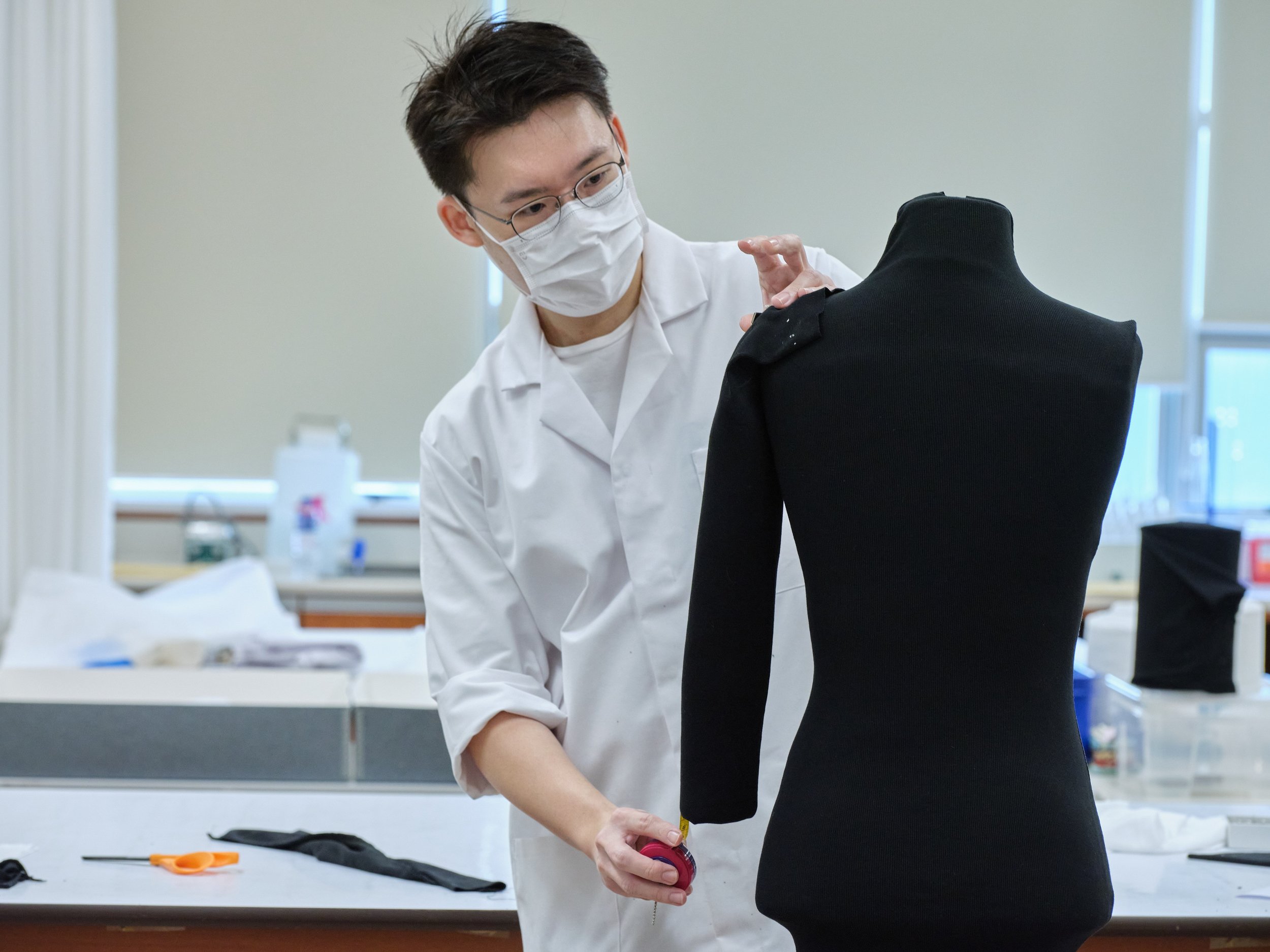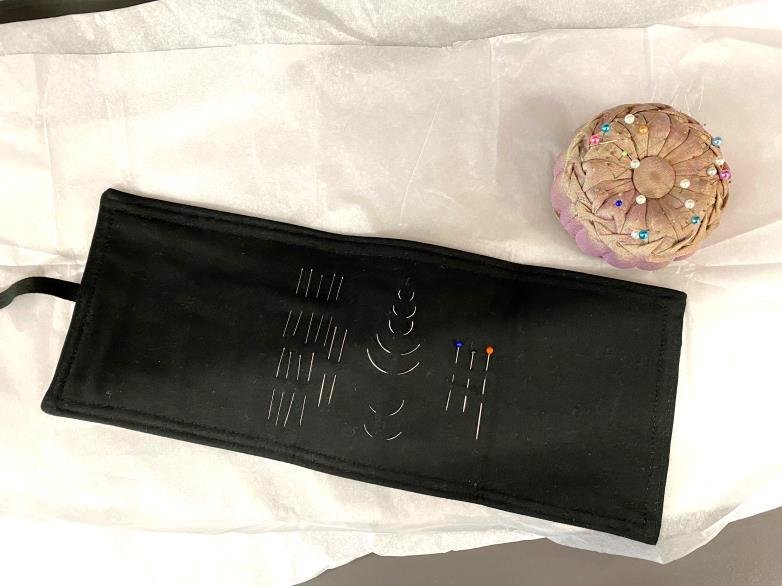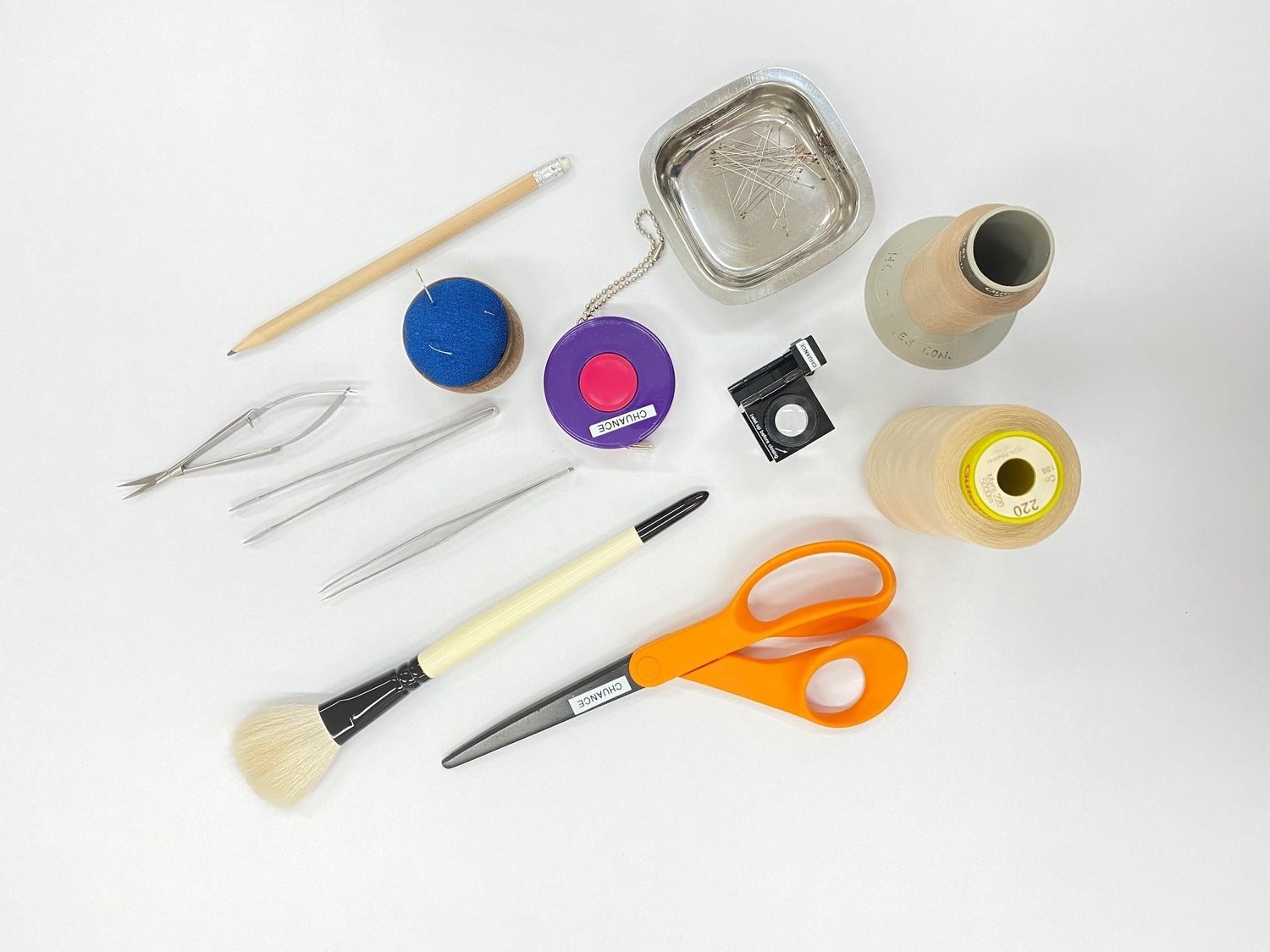Conversation with Textile Conservator Chuance Chen
The practice of textile conservation in Singapore
Chuance Chen is a Singapore textile conservator who works at the Heritage Conservation Centre, a conservation facility under the National Heritage Board that manages and preserves Singapore’s National Collection. He graduated with an MPhil in Textile Conservation from the University of Glasgow in 2019 and has a BSc in Marketing from the Singapore Institute of Management and a Diploma in Apparel Design and Merchandising from Temasek Polytechnic.
Chuance has been working at the institution since 2009 and his work predominantly comprises interventive conservation treatment and methods of display for costume and textile conservation projects. He was the textile conservator-in-charge for several special exhibitions in Singapore, including Beauty in Black (2011) at the National Museum of Singapore, Nyonya Needlework: Embroidery and Beadwork in the Peranakan World (2017) at the Peranakan Museum, and most recently, Andrew Gn: Fashioning Singapore and the World (2023) at the Asian Civilisations Museum.
In this conversation, Chuance shares more details of his multi-faceted practice as a textile conservator, including highlights from his career thus far, and research and work he has conducted to hone his skills.
Chuance Chen.
To start, could you talk about your background and how were you first introduced to textile conservation? At what point did you decide to pursue a career as a conservator?
I studied at Temasek Polytechnic and received a Diploma in Apparel Design & Merchandising. After graduating, I worked as a fashion designer for three years before deciding to continue my studies. I was accepted at Central Saint Martins, but because the tuition was expensive, I decided to stay in Singapore. I went on to pursue a BSc in Marketing at the Singapore University of Social Science.
Before I started my practice as a fashion designer, I was actually keen on becoming a textile designer. In 2009, I stumbled upon Heritage Conservation Centre’s opening for a Conservation Officer in the textile section and decided to give it a try. I was accepted for the role without having extensive knowledge of textile conservation. Although I had to adjust from my previous practice as a fashion designer, I enjoy the process of conserving artefact and artwork, and the role has grown on me.
There is a common perception that fashion design students will have a career as a designer after they graduate, but this is not necessarily true. There are some transferable skills from when I worked as a fashion designer. For example, fashion designers work ahead of time to create a collection for the fashion seasons. When planning an exhibition at a museum, we also work six to nine months in advance, and even up to two to three years ahead for a blockbuster exhibition. This is my 14th year working at the Heritage Conservation Centre. I am happy with my current role, and it is a place for me to establish myself as a textile conservator.
Details of the conservation stitching technique on a child's vest with embroidery and gold couching, circa 1909. Collection of the National Museum of Singapore, National Heritage Board. Gift of Mdm. Chan Poh Choo.
You started your career as a textile conservator at The Heritage Conservation Centre in 2009 and have been working there since. Could you tell us what your scope of work includes at The Heritage Conservation Centre and if you have a particular area of expertise?
To broadly cover my scope of work, I see three main categories in my role as a textile conservator: conservation, research, and outreach. For conservation, I carry out interventive and preventive work on textiles. Interventive work consists of stabilising the object’s condition by performing interventive treatments directly on the item using specialised techniques such as conservation stitching and aqueous treatment.
Chuance carrying out a mount-making process as a part of preventive work. Image courtesy of Chuance Chen.
Mount-making sketches for a black Balenciaga tunic and skirt ensemble, circa early 1960s, collection of the National Museum of Singapore, National Heritage Board.
Preventive treatments focus on working on the environment of the collection item to minimise its rate of deterioration. For instance, using customised mount to provide structural support to an artwork. One notable example in textile conservation is creating textile or costume mounts for displaying textiles. An important first step is material identification to help provide insights for guiding conservation decisions. Working with the Heritage Conservation Centre is unique as it provides exhibition support to the national museums and institutions. As a result, I am heavily involved in exhibition installation processes, including on-site installation and de-installation, environmental monitoring for spaces, and gallery maintenance work.
Research is typically carried out in collaboration with colleagues from other departments as well as curators from the museums. As a conservator, we also have our own areas of interest. I take a special interest in painted textiles, which consists of two types: two-dimensional, which are flat textiles, and three-dimensional textiles that are usually in the form of garments. Working with the latter is especially exciting for me.
There is a range of techniques applied in conservation that originated from, and are mainly practised in Western countries. These techniques are practised and adapted in context to our collection and local climate. Textile conservation is not something that is based only on studying. Building experience is key, including being more outward-looking, learning from treatment work and observing how people work as well.
“Textile conservation is not something that is based only on studying. Building experience is key, including being more outward, learning from treatment work and observing how people work as well.”
The last aspect of my core work is outreach, where I engage with members of the public to advocate for textile conservation through talks and sharing sessions. I also interact with visitors through exhibition tours. Many people have little awareness about textile conservation, though that is changing. It is heartwarming when people come to visit me to ask about my work. I guess this is also because the Heritage Conservation Centre has been organising conservation outreach activities, for example with The World of Heritage Conservation: Sneak Peeks into Safeguarding Singapore’s National Collection, a travelling exhibition last displayed at the National Library in 2021. We hope initiatives like this increase the profile of the conservation profession.
I would like to know what a typical day in your life is like as a textile conservator at The Heritage Conservation Centre.
I start my day by switching on my laptop to check emails. Working as a conservator, I spend most of the time in the lab conserving artworks, so I am not always in front of the laptop. My role also requires me to be the conservation representative for exhibitions, where I have to manage and liaise with museums, curators, designers, and fabricators to make sure that all of the exhibition requirements are fulfilled. It is all about getting information out there and giving out professional advice so that they can implement it in an exhibition.
Another thing that I would do in the office is conduct experiments. I am also involved in sharing knowledge with my colleagues, such as how I have stabilised an area of damage. Since conservation relies a lot on hands-on learning, it is nice to work with other conservators as a group where we can exchange ideas and techniques.
Curve needles and insect pins. Image courtesy of Chuance Chen.
Chuance’s toolkit. Image courtesy of Chuance Chen.
What kind of tools do you use in your everyday practice?
I use specific tools when working with textiles. One of them is a curved surgical needle, which I have in various sizes. Other items in my toolkit are insect pins, brushes, measuring tape, threads, and a squeezer, which is similar to a thread cutter and cuts with a spring mechanism. I also work with different supporting fabrics that we use for conservation purposes, including mount-making and dyeing fabric for treatment use.
What are your favourite parts of the job and which are the hardest?
My favourite part of the job is anything that is hands-on. Conservators also attend workshops to increase technical knowledge of textiles, or in specific areas of treatment technique. One of the most challenging parts is finding more time to do treatments. A lot of exhibitions have tight timelines, so we need to make sure we finish what is necessary.
A close-up of the conservation stitching technique on an orange floral lace jacket for a sleeveless cheongsam, 1960s-1970s. Collection of the National Museum of Singapore, National Heritage Board. Gift of Judy Lee.
Are there any particular skills that you feel are unique to or important to your discipline?
I would say the textile conservation method of stitching is unique to my practice. It is a set of stitches that conservators use to stabilise the textile. I think that the understanding of construction and textiles is important to a textile conservator because they are interrelated. For instance, when you are working on a heavy woven textile, you have to know how it was constructed to be able to see how it is going to drape and stay on the mannequin, and whether the mannequin itself is the right fit.
We also produce condition treatment reports where we document the construction and the techniques used. We put in all our findings to be able to differentiate the damage of the textiles, which helps a lot when you have grounding in these two areas. Such documentation is also used to monitor the condition of the textiles, providing evidence on how adequate the provided collection care is.
What do you think is the importance of textile conservation? And what are some of the misconceptions about the work that you do?
Textile is a vulnerable material. It is hard to come across a piece of aged textile that is in good condition and has a stable structure. While restoration is to make the artwork look new, conservation preserves what is existing. I feel it is important to preserve textiles for longevity, and for the next generation to understand the craft and culture; supporting the creation of a tangible link between generations.
“I feel it is important to preserve textiles for longevity, and for the next generation to understand the craft and culture; supporting the creation of a tangible link between generations.”
Chuance doing treatments to a yellow dress with matching handbag and necklace, 1928. Collection of the National Museum of Singapore, National Heritage Board.
A lot of people also think that we treat the fabric with a sewing machine. Visitors often ask whether we use sewing machines to conserve the textile. All interventive stitching work has to be done by hand. We use sewing machines to create textile mounts.
Before I joined the profession, I had the misconception that conservation would be a slow-paced, quiet, and individual working environment. However, now I know that it is one of the careers to start early so that you are more familiar with the collections and to build on the manual dexterity required as a textile conservator. This knowledge aids conservators in devising conservation recommendations.
Photo of ACM Fashion and Textiles Gallery (2022).
Gown, made from Chinese painted silk fabric. Collection of the Asian Civilisations Museum.
What have been highlights in your career so far?
A highlight has been working on a 18th-century gown made with Chinese-painted silk fabric that was acquired by the Asian Civilisations Museum. I spent more than 400 hours in total to conserve it, from testing the materials, developing the treatment method, and doing in-depth analysis of the paint pigments together with the conservation scientists. These information and findings were compiled in the report for proper documentation. The piece has been in the lab for around a year since I needed more time to finish the treatment. It was installed at the museum’s Fashion and Textiles Gallery in September 2022 and was de-installed in January this year.
I am also pleased to share that I will be presenting a poster on the adhesive treatment used in conserving this textile at the North American Textile Conservation Conference, which will be at Colonial Williamsburg in Virginia, USA this October.
Photo of Andrew Gn: Fashioning Singapore and the World. Asian Civilisations Museum (2023).
Another highlight of my career is being involved as the conservation lead in the Andrew Gn: Fashioning Singapore and the World exhibition which opened on 27 May at the Asian Civilisations Museum. The process of exhibition planning was distinctive as both conservator and curator had to work closely with the designer for display interpretation.
You have worked as a textile conservator for around 14 years. How has the field evolved?
We see more new materials and techniques in the textiles acquired into the national collection. One example is fabrics with synthetic fibres. As textile conservators, we need to keep ourselves updated in terms of techniques and technology. We attend conferences to find out what conservators in other countries are currently doing and explore its application for our own practices. I think this is meaningful as it suggests a way to refresh my mindset and helps me to see new perspectives on the things that I practise daily. When we see others using materials we have not thought of using in conservation, it also propels a more dynamic way of thinking. Such conferences also provide the opportunity to share with peers observation on innovative materials explored in the fashion and art industry, for which information on ageing behaviours and associated care is still under development.
Are there any items on your “wishlist” you wish to work on as a textile conservator? Lastly, is there a project you are working on now that you may be able to share?
Moving forward, I want to keep expanding my knowledge by doing more research and taking on more complex treatments. The latest exhibition that I worked on was the third iteration of #SGFASHIONNOW by Asian Civilisations Museum. It is currently showcased at the ASEAN Culture House in Busan, South Korea until 29 October. There are twelve National Collection pieces featured in the exhibition.
After this, I will be working on a two-dimensional contemporary batik for another textile exhibition that will also be travelling to Korea. I am still examining the textile and discussing with the curators on how to mount it, so I am unable to share more information. I think it is an exciting opportunity to showcase our National Collection on an international scale. There is also a global surge of fashion exhibitions and I hope to see more of them in museums in Singapore.
This interview has been edited for clarity and length.













